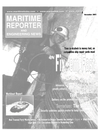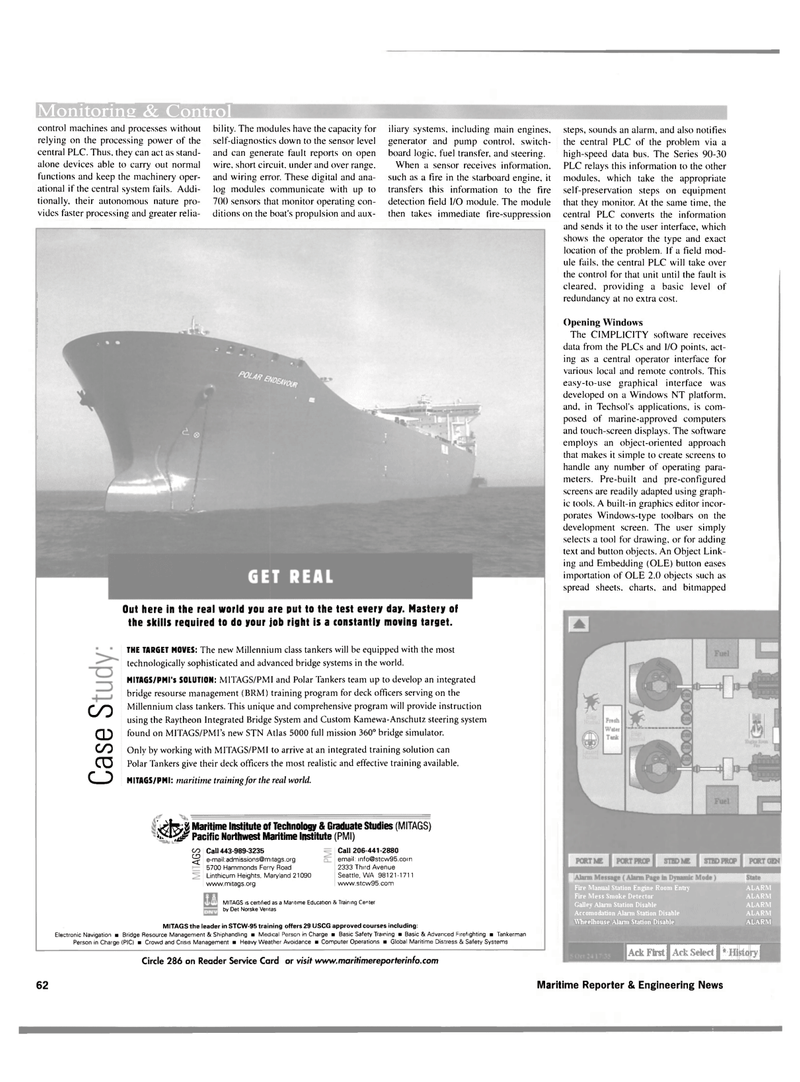
Page 62: of Maritime Reporter Magazine (November 2001)
Read this page in Pdf, Flash or Html5 edition of November 2001 Maritime Reporter Magazine
Monitoring & Control control machines and processes without relying on the processing power of the central PLC. Thus, they can act as stand- alone devices able to carry out normal functions and keep the machinery oper- ational if the central system fails. Addi- tionally, their autonomous nature pro- vides faster processing and greater relia- bility. The modules have the capacity for self-diagnostics down to the sensor level and can generate fault reports on open wire, short circuit, under and over range, and wiring error. These digital and ana- log modules communicate with up to 700 sensors that monitor operating con- ditions on the boat's propulsion and aux- iliary systems, including main engines, generator and pump control, switch- board logic, fuel transfer, and steering.
When a sensor receives information, such as a fire in the starboard engine, it transfers this information to the fire detection field I/O module. The module then takes immediate tire-suppression
GO
CD
O0
CD
CJ>
Out here in the real world you are put to the test every day. Mastery of the skills required to do your job right is a constantly moving target.
THE TARGET MOVES: The new Millennium class tankers will be equipped with the most technologically sophisticated and advanced bridge systems in the world.
MITAGS/PMI's SOLUTION: M1TAGS/PMI and Polar Tankers team up to develop an integrated bridge resourse management (BRM) training program for deck officers serving on the
Millennium class tankers. This unique and comprehensive program will provide instruction using the Raytheon Integrated Bridge System and Custom Kamewa-Anschutz steering system found on MITAGS/PMI's new STN Atlas 5000 full mission 360° bridge simulator.
Only by working with MITAGS/PMI to arrive at an integrated training solution can
Polar Tankers give their deck officers the most realistic and effective training available.
MITAGS/PMI: maritime training for the real world. '^fr&tf Maritime Institute of Technology & Graduate Studies (MITAGS) iJsi-^ Pacific Northwest Maritime Institute (PMI) oo
CD <
Call 443-989-3235 e-mail: admissions@mitags. org 5700 Hammonds Fern/ Road
Linthicum Heights, Maryland 21090 www.mitags.org
Call 206-441-2880 email: info@stcw95 corn 2333 Third Avenue
Seattle, WA 98121-1711 www.stcw95.com
MITAGS is certified as a Maritime Education & Training Center by Det Norske Veritas
MITAGS the leader in STCW-95 training offers 29 USCG approved courses including:
Electronic Navigation • Bridge Resource Management & Shiphandling • Medical Person in Charge • Basic Safety Training • Basic & Advanced Firefighting • Tankerman
Person in Charge (PIC) • Crowd and Crisis Management • Heavy Weather Avoidance • Computer Operations • Global Maritime Distress & Safety Systems steps, sounds an alarm, and also notifies the central PLC of the problem via a high-speed data bus. The Series 90-30
PLC relays this information to the other modules, which take the appropriate self-preservation steps on equipment that they monitor. At the same time, the central PLC converts the information and sends it to the user interface, which shows the operator the type and exact location of the problem. If a field mod- ule fails, the central PLC will take over the control for that unit until the fault is cleared, providing a basic level of redundancy at no extra cost.
Opening Windows
The CIMPLICITY software receives data from the PLCs and I/O points, act- ing as a central operator interface for various local and remote controls. This easy-to-use graphical interface was developed on a Windows NT platform, and, in Techsol's applications, is com- posed of marine-approved computers and touch-screen displays. The software employs an object-oriented approach that makes it simple to create screens to handle any number of operating para- meters. Pre-built and pre-configured screens are readily adapted using graph- ic tools. A built-in graphics editor incor- porates Windows-type toolbars on the development screen. The user simply selects a tool for drawing, or for adding text and button objects. An Object Link- ing and Embedding (OLE) button eases importation of OLE 2.0 objects such as spread sheets, charts, and bitmapped
Circle 286 on Reader Service Card or visit www.maritimereporterinfo.com
Fire Manual Station Engine Room Entiy ALARM
Fire Mess Smoke Detector ALARM
Galley Alarm Station Disable ALARM
Accomodation Alarm Station Disable ALARM
Wheelhouse Alarm Station Disable ALARM
GS3SS3 ES2S99 BBS S Si 62 Maritime Reporter & Engineering News

 61
61

 63
63
